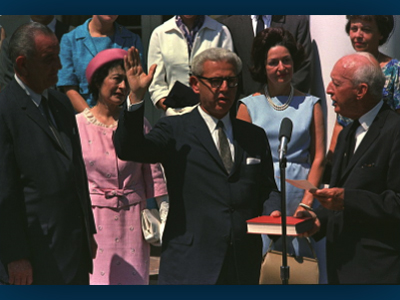
January 19, 1990
Arthur Goldberg, former United States Supreme Court Justice, Secretary of Labor and American Ambassador to the United Nations passes away at the age of 81 at his home in Washington, DC. Born in Chicago in 1908, Goldberg became a lawyer in 1930 and practiced law in Chicago, focusing on labor law. In 1948, he became the general counsel for the United Steelworkers of America and played a prominent role in the 1955 merger of the American Federation of Labor and the Congress of Industrial Organizations.
President Kennedy named him to the post of Secretary of Labor in 1961 and to the Supreme Court in September 1962 after the retirement of Felix Frankfurter. In 1965, President Johnson approached Goldberg and asked him to become the United States Ambassador to the United Nations. Goldberg accepted the position after an initial hesitation because he was hopeful that in his new role, he could help bring about an end to the Vietnam War. The photo shows Goldberg being sworn in for his post at the United Nations.
Although he was unable to accomplish his primary goal at the United Nations, he would resign in frustration in April 1968, Arthur Goldberg played a prominent role as one the chief authors of and primary negotiator for UN Resolution 242 in 1967. For nearly five monthts, the exact text of the resolution was carefully debated in the Security Council and General Assembly. Finally, Lord Caradon of Great Britain would evolved the final draft in November 1967. Goldberg would play a primary role in its adoption.
The Resolution became the context and framework for subsequent official Arab-Israeli negotiations. The central concept in the Resolution was an Israeli exchange of land won in the 1967 War – some or all of the Sinai Peninsula, the Golan Heights, portions of Jerusalem, the West Bank and the Gaza Strip – for peace and recognition to be granted by Arab neighbors and states. While the Resolution prescribed, the notion of “land for peace,” it was intentionally worded to serve as a basis for negotiations and did not specify which lands.
According to Goldberg in a 1988 article entitled, What Resolution 242 Really Said, “The resolution does not explicitly require that Israel withdraw to the lines that it occupied on June 5, 1967, before the outbreak of the war. The Arab states urged such language; the Soviet Union proposed such a resolution to the Security Council in June 1967, and Yugoslavia and other nations made a similar proposal to the special session of the General Assembly that followed the adjournment of the Security Council. But those views were rejected. Instead, Resolution 242 endorses the principle of the “withdrawal of Israeli armed forces from territories occupied in the recent conflict” and juxtaposes the principle that every state in the area is entitled to live in peace within “secure and recognized boundaries.” (Goldberg, Arthur, “What Resolution 242 Really Said,” in American Foreign Policy Interests, Jan/Feb 2011, Vol. 33 Issue , p.44)
